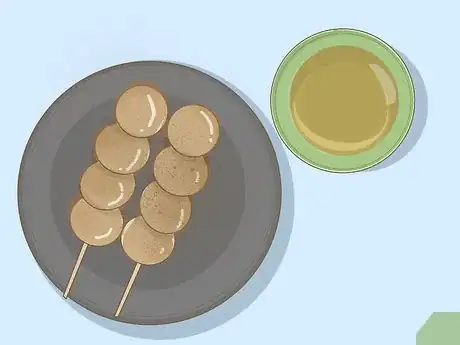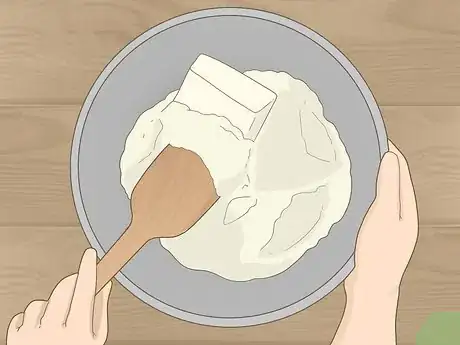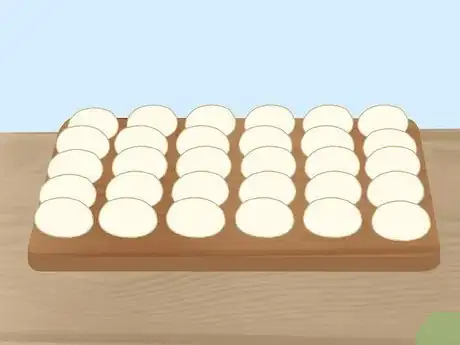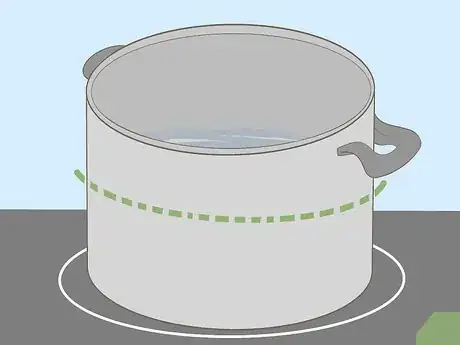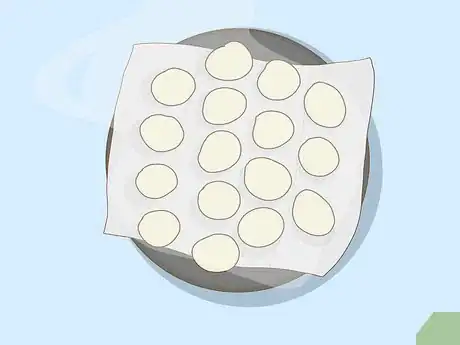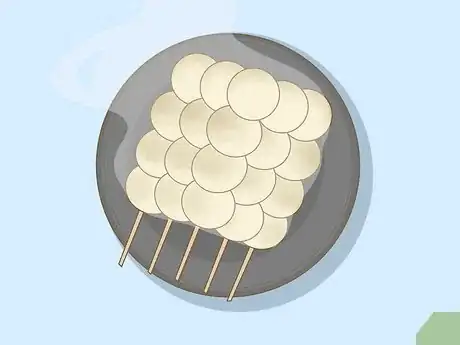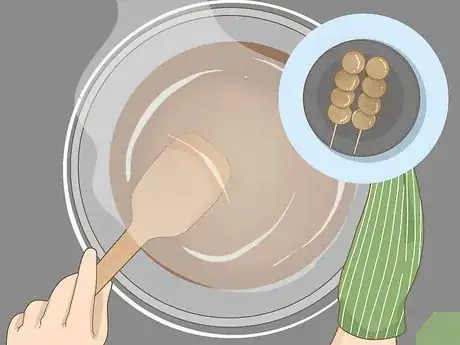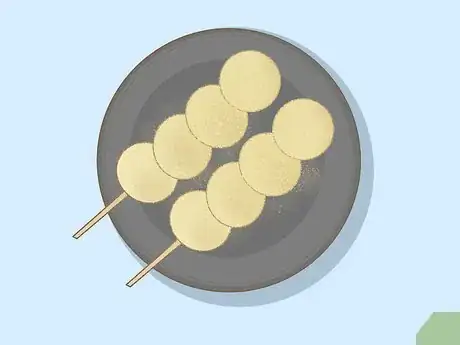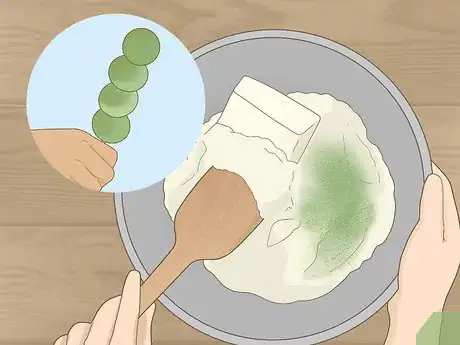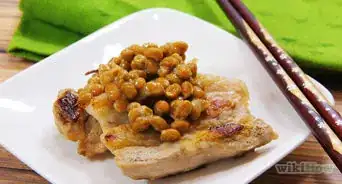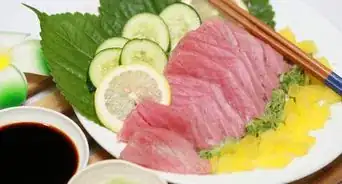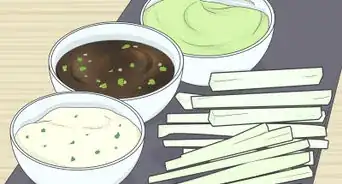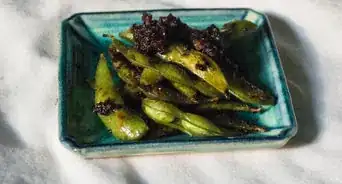This article was co-authored by wikiHow Staff. Our trained team of editors and researchers validate articles for accuracy and comprehensiveness. wikiHow's Content Management Team carefully monitors the work from our editorial staff to ensure that each article is backed by trusted research and meets our high quality standards.
This article has been viewed 15,072 times.
Learn more...
Dango is a very popular Japanese food, often served as dessert along with a cup of green tea. You can also buy dango from street vendors and at popular Japanese festivals. If you want to make these delicious treats at home, you only need a few simple ingredients and 30 minutes or so of time. Once you’ve mastered the art of making dango, you can add different toppings or flavors to mimic ones you would find in Japan.
Ingredients
- 1 cup (250 grams) silken tofu (soft tofu)
- 1 cup (200 grams) sweet rice flour (mochiko flour)
Makes about 30 dango
Steps
Enjoying Fresh Dango in Japan
-
1Buy fresh dango from convenience stores, street vendors, and at festivals. Dango is one of the more popular treats you’ll find in Japan, and you can enjoy it all year long. Look for a vendor who is making the dango right in front of you for the freshest variety.[1]
- You’ll usually get 3-5 dango on a skewer. Because you don’t need any utensils to eat them, they make a great on-the-go snack as you’re traveling.
-
2Enjoy dango while it’s still warm for the best flavor. Don’t wait to eat your dango until you’ve gotten back to your hotel room—start enjoying it right away for the optimal flavor and experience. As the dango cools down, it gets chewier and chewier.[2]
- Each dango is usually pretty small, so don’t worry about ruining your appetite if you buy a skewer close to dinner.
Advertisement -
3Hold the end of the skewer and bite the dango right off. Avoid pulling the dango off with your fingers and eating it by hand—the skewer is meant to help keep your hands clean. Bite through the dango until you feel the skewer with your teeth, then pull off the piece to enjoy it.[3]
- Try tilting your head back a little as your bite down on the dango.
- Be careful to not accidentally pierce your mouth with the skewer! If you’re worried about tripping while you’re eating and walking, stop for a few moments on the street to take a bite before moving on.
-
4Keep plenty of napkins nearby to wipe your hands and mouth. Depending on what kind of dango you got, there may be a sticky sauce or loose toppings you have to contend with. If you’re walking and eating, stick a few napkins into your pocket or wrap one around the end of the skewer so it’s ready when you need it.[4]
- Wet wipes may be more effective at cleaning sticky hands than a napkin would be. If you have them with you, use them to wipe down your hands after you finish eating.
-
5Pair dango with a fresh cup of green tea for a complete snack. Traditionally, green tea is served with dango for breakfast or an afternoon treat. If you have the opportunity, sit down in a cafe to enjoy a cup of freshly brewed tea along with warm dango.[5]
- Green tea contains a little bit of caffeine, which can make it a nice pick-me-up in the afternoon.
-
6Order mitarashi dango if you’re craving a sweet, salty treat. These dango are covered in a shiny, sticky sauce made from soy sauce and sugar. The sauce is used to glaze the dango, making this one of the stickier varieties you can buy.[6]
- Even though the sauce is made with sugar, this version of dango still isn’t super sweet. Japanese desserts tend to be much less sweet than what you may think of as a traditional dessert if you’re from the United States or Canada.
-
7Get tri-colored bocchan dango to enjoy a variety of different flavors. Though the flavors are subtle, this skewer with a variety of colors is really popular festival food. Green dango is made from matcha powder, red dango from red bean paste, and the yellow dango is colored with eggs.[7]
- Hanami dango is another three-colored version you will find during the cherry blossom season. These skewers hold, red, green, and white dango and are often covered with a red bean jelly.
-
8Eat denpun dango for a potato-flour-based treat that is especially filling. If you’re looking for a snack that is a little more substantial, get denpun dango. Potato flour and sweet beans are mixed together and sometimes even stuffed with red bean paste to create a more dense dessert.[8]
- This denpun may also be rolled in sesame seeds or dusted with soy powder for a crunchy exterior.
Making Homemade Dango
-
1Mix the tofu and sweet rice flour in a clean bowl. Measure 1 cup (250 grams) of silken tofu and 1 cup (200 grams) of sweet rice flour into a bowl and mix them by hand. Continue mixing and kneading the dough until the ingredients are fully incorporated and form a soft, smooth ball of dough.[9]
- You can buy both silken tofu and sweet rice flour at many big-name grocery stores. You could also get them from a Japanese grocery store or order them online.
- If the dough is crumbly, add a spoonful more of tofu until the consistency is smooth.
- Fix dough that is too wet by adding one spoonful of rice flour at a time until it holds together.
Warning: You’ll be touching the dough often, so make sure to wash your hands before starting.
-
2Separate the dough into about 30 small, round balls. Use a tablespoon to scoop out small circles of dough, and then roll them between your palms to even them out. Repeat until all the dough has been used. Place the newly formed dough balls on a clean plate.[10]
- Try your best to keep the dough balls roughly the same size so they cook through at the same time.
-
3Bring a large pot of water to a boil on the stovetop. Fill the pot 1/2 way full of water and heat it over a high flame. If you need to move the pot for any reason, make sure to put on oven mitts before touching it so you don’t burn your hands.[11]
- There’s no need to salt the water or add anything else to it.
-
4Drop the dough balls into the boiling water. Carefully place each dough ball into the pot until the surface is covered. If you still have dough leftover that doesn’t fit, you’ll need to wait and do a second batch to avoid overcrowding the dango.[12]
- If you’re worried about getting splashed by the hot water, you could use a slotted spoon to lower the dough balls into the pot.
-
5Boil the dough balls and cook them for 2-3 minutes after they float. Making dango isn’t an exact science, so make sure to pay close attention to the pot so you know when they’re done. Once the balls float to the top of the water, let them cook for several additional minutes to ensure they’re cooked all the way through.[13]
- Letting the dough cook through gives it an even consistency. If you took the dango out too soon, the middle might be very dense and unpleasant to chew.
-
6Ladle the balls out of the water and lay them on a paper-towel-lined plate. Use a slotted spoon to gently lift each ball out of the pot. If you need to, use multiple plates to hold all the dango. The paper towels help absorb any water that is still dripping.[14]
- You could also place the dango on a cooling rack.
-
7Skewer 3-5 dango and lightly brown them in a non-stick frying pan. Use long wooden skewers to pierce the dango. Heat a non-stick pan over medium heat, then roast each skewer for about 30 seconds on each side, or until the outside of the dango gets lightly browned.[15]
- Not everyone likes their dango fried. It helps keep them warm and can add a little texture to the outside, but it isn’t required.
-
8Enjoy dango while they’re still warm on their own or with a special sauce. Dango is often enjoyed plain, but there are also a few traditional toppings that can add something special to this famous Japanese dumpling. They’re easy to eat on-the-go and make great party and festival foods.[16]
- To reheat dango, simply pop them into the microwave for 15-30 seconds until they’re warmed through.
- You can store dango in an air-tight container for up to 2 days at room temperature.
Adding Homemade Toppings and Flavors
-
1Make the classic mitarashi dango with a sweet-and-salty syrup. Heat 2 1⁄2 tablespoons (37.0 ml) (10 grams) of corn starch, 1/2 cup (104 grams) of sugar, 5 tablespoons (74 mL) of soy sauce, and 1 cup (240 mL) of water in a small saucepan. Bring the sauce to a boil over medium-high heat, stirring it frequently until the sugar dissolves and it thickens enough to stick to the back of a spoon.[17]
- This sauce can be drizzled over warm dango, or the dango can be dipped into the syrup.
Enjoy Dango with Green Tea: These special treats are commonly served with a cup of hot green tea. Make a cup for yourself or a pot for guests the next time you serve dango.
-
2Cover your dumplings in a red bean paste to make anko dango. Soak 1 cup (200 grams) of red beans overnight to soften them. The next day, drain the beans and add them to a pot along with 3 cups (710 mL) of fresh water. Boil the beans for about 40 minutes or until they are soft enough to smash. Press the beans through a strainer or puree them in a food processor. Reheat them in a pan with 1 cup (208 grams) of sugar, 2 tablespoons (29.6 ml) (30 grams) of butter, and a teaspoon (6 grams) of salt. Stir everything together over low heat until a sticky paste forms.[18]
- Spread the paste over the dango to enjoy this traditional topping.
- Red bean paste will keep for up to 2 weeks in an air-tight container stored in the fridge.
- You could also mix a tablespoon of red bean paste into the dough the next time you make dango.
-
3Add a dusting of soy flour to make sweet-and-salty kinako dango. In a small bowl, mix 1/2 cup (64 grams) of kinako, 2 tablespoons (29.6 ml) (25 grams) of sugar, and 1/2 teaspoon (3 grams) of salt. Roll the freshly made dango ball in the mixture to add a slightly crunchy, sweet-and-salty topping.[19]
- Kinako is often called roasted soy flour and is made from roasted soybeans. You can find it at Japanese grocery stores, or you may have to order it online.
-
4Infuse your dumplings with green tea to make chadango. Simply add 1 tablespoon (14.8 ml) (6 grams) of matcha powder to the dough before you boil it. Work it in as you’re mixing the tofu and sweet rice flour so that the color evenly distributes throughout the dough.[20]
- It’s very common to see red, green, and white dango served together on a skewer. Once you know how to mix in matcha or red bean paste to the dough, it’s very simple and fun to create these multi-colored skewers.
Things You’ll Need
Making Dango at Home
- Bowl
- Measuring cups
- Spoon
- Plate
- Pot
- Oven mitts
- Slotted spoon
- Paper towels
- Wooden skewers
- Non-stick frying pan
Adding Homemade Toppings and Flavors
- Measuring cups
- Spoon
- Small saucepan
- Pot
- Strainer or food processor
- Bowl
References
- ↑ https://favy-jp.com/topics/2897
- ↑ https://favy-jp.com/topics/2897
- ↑ https://www.japan-talk.com/jt/new/dango
- ↑ https://www.japan-talk.com/jt/new/dango
- ↑ https://www.japan-talk.com/jt/new/dango
- ↑ https://matcha-jp.com/en/3318
- ↑ https://matcha-jp.com/en/3318
- ↑ https://matcha-jp.com/en/3318
- ↑ https://www.japanesecooking101.com/mitarashi-dango-recipe/
- ↑ https://www.japanesecooking101.com/mitarashi-dango-recipe/
- ↑ https://www.japanesecooking101.com/mitarashi-dango-recipe/
- ↑ https://www.japanesecooking101.com/mitarashi-dango-recipe/
- ↑ https://www.japanesecooking101.com/mitarashi-dango-recipe/
- ↑ https://www.japanesecooking101.com/mitarashi-dango-recipe/
- ↑ https://www.japanesecooking101.com/mitarashi-dango-recipe/
- ↑ https://www.japanesecooking101.com/mitarashi-dango-recipe/
- ↑ https://www.japanesecooking101.com/mitarashi-dango-recipe/
- ↑ https://www.chinasichuanfood.com/sweet-red-bean-paste/
- ↑ https://matcha-jp.com/en/3318
- ↑ https://matcha-jp.com/en/3318
- ↑ https://www.chinasichuanfood.com/sweet-red-bean-paste/
- ↑ https://matcha-jp.com/en/3318




